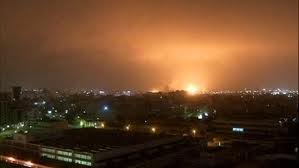NATO Launches Bombing Blitzkrieg over Tripoli hitting Residential Areas

TRIPOLI, Global Research. July 17, 2011 3:30 EET – NATO started a bombing blitzkrieg in Tripoli which lasted initially for almost two hours, from approximately 12:00 to 12:30 a.m. EET to 2:00 a.m. local time (EET). Then there was a period of silence until approximately 2:30 a.m. and later at 2:45 a.m. EET large explosions could be heard in the distance.
Multiple urban areas were bombed simultaneously this morning. Anywhere from 60 to 75 bombs may have been dropped mostly in the areas of Tajura and Seraj, according to eyewitness reports.
Libyan television reported that the “NATO crusader forces” had hit civilian and military targets in the eastern suburb of Tajura.
Residential areas were greatly disturbed and affected by the NATO attacks. Casualties and damages will be known in the morning.
In the vicinity of the bombing, it was like an earthquake. Large buildings as far away on Al-Fatah Street on the Mediterranean coast were shaking.
Dogs began howling in alarm and panic all over the city. Other animals, including birds and cats, also began to make noises in panic as the bombings took place. Usually after the bombings dead insects and birds litter some of the streets.
The smell of burning and a strange smoldering filled the air. The smell lingered in the air. It even remained on the skin in the wake of the bombings.
Until approximately 2:35 a.m EET, the strident noises of fighter jets over Tripoli could be heard. The bomb blasts triggered an atmosphere of fear and panic over the entire city, a poignant psychological and emotional impact on tens of thousands of people, from the young to the elderly. It also alerted people and brought them out onto their balconies while they witnessed the bombing of their country.
One of the explosions resulted in a huge mushroom cloud, pointing to the possible use of bunker buster bombs. There was also evidence of anti-aircraft activity.
There was something unusual in the pattern of this NATO bombing operation.
The bombings tonight were not like other nights. The sounds were different. The smoke plumes were different.
In previous bombings the smoke would usually go up vertically like a fire, but tonight the smoke plumes were horizontal and hovering above Tripoli with a white cloud in the horizon.
People who were not directly affected by the bombs, within a radius of 15 kilometres experienced burning eyes, lower back pain, headaches.
Mahdi Darius Nazemroaya is a Research Associate of the Centre for Research on Globalization (CRG) and Global Research’s Correspondent in Libya.

